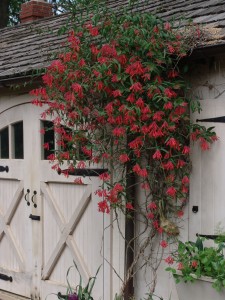Climbing or coral honeysuckle (Lonicera sempervirens) is a native vine. It can be spotted growing on fence rows along roadsides and in woodlands from Connecticut to Nebraska, and south to Texas and Florida. ‘Major Wheeler’ is one of the better climbing honeysuckles noted for its non-stop production of bright red trumpet flowers and green mildew resistant foliage.
Red tubular flowers cover the vine in mid- to late spring, and it continues to scatter blooms all summer long. Major Wheeler becomes a major hummingbird and butterfly magnet from miles around. Flowers form on both previous year’s and current season’s wood.
Climbing honeysuckle grows in full sun to partial shade and in average soils. Flower numbers are heaviest in full sun. Fertilizing is generally not needed unless growth and flowering are not prolific in infertile soils. Once established, Major Wheeler is very drought tolerant.
Rate of growth is fast, estimated at 8-12 feet per year. Prune annually to tidy up the enormous mass of growth. Ideal pruning time is immediately after the major spring bloom flush. Pruning will spur re-growth and new flowering. Expect removal of 50-80% of the old growth after pruning is completed.
Train on a sturdy fence, trellis or arbor from the beginning. Major Wheeler will quickly cover over any old fence that may be an eyesore. Its mildew resistance is outstanding compared to other varieties. Occasionally, aphids and scale insects may infest climbing vines, necessitating spraying with Bayer Advanced Garden Insecticide™, Malathion, or acephate (Orthene™).
‘Major Wheeler’ climbing honeysuckle was found by Charles Wheeler, the former president of the NC Botanical Gardens and is winter hardy to USDA zone 4.


 Posted in
Posted in 
